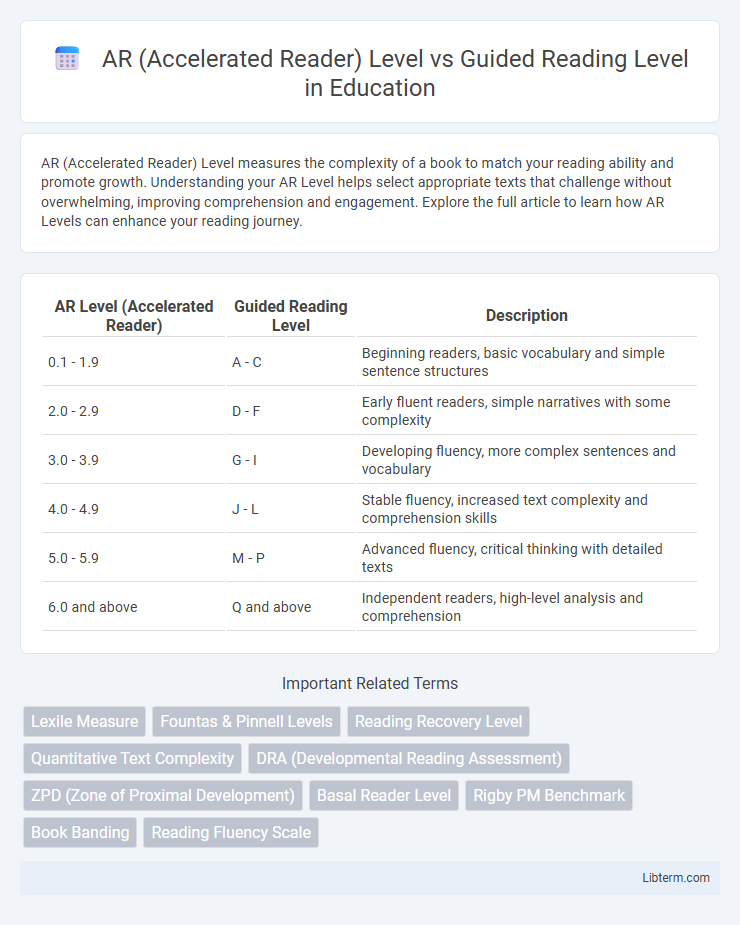AR (Accelerated Reader) Level measures the complexity of a book to match your reading ability and promote growth. Understanding your AR Level helps select appropriate texts that challenge without overwhelming, improving comprehension and engagement. Explore the full article to learn how AR Levels can enhance your reading journey.
Table of Comparison
| AR Level (Accelerated Reader) | Guided Reading Level | Description |
|---|---|---|
| 0.1 - 1.9 | A - C | Beginning readers, basic vocabulary and simple sentence structures |
| 2.0 - 2.9 | D - F | Early fluent readers, simple narratives with some complexity |
| 3.0 - 3.9 | G - I | Developing fluency, more complex sentences and vocabulary |
| 4.0 - 4.9 | J - L | Stable fluency, increased text complexity and comprehension skills |
| 5.0 - 5.9 | M - P | Advanced fluency, critical thinking with detailed texts |
| 6.0 and above | Q and above | Independent readers, high-level analysis and comprehension |
Understanding AR (Accelerated Reader) Level
The AR (Accelerated Reader) Level measures a student's reading ability and comprehension through a point system based on book difficulty and quiz performance, offering a quantifiable metric to track progress. Guided Reading Level categorizes texts by complexity using criteria such as vocabulary, sentence length, and content, helping educators select appropriate reading materials. Understanding AR Level enables educators to align students with books that match their proficiency, optimize reading development, and promote measurable growth in literacy skills.
What Is Guided Reading Level?
Guided Reading Level (GRL) is a system that categorizes books based on text complexity, vocabulary, and sentence structure to match a student's reading ability and support targeted instruction. Unlike Accelerated Reader (AR) levels, which focus on comprehension quizzes and point accumulation, Guided Reading Levels help educators select appropriate texts for differentiated reading groups and skill development. GRL scales from A to Z, with A representing beginner readers and Z indicating advanced proficiency.
Key Differences Between AR Level and Guided Reading Level
AR Level measures a student's reading ability using a numerical scale based on book difficulty and comprehension quizzes, while Guided Reading Level categorizes texts alphabetically from A to Z, focusing on instructional reading stages. AR Level is primarily designed to match students with appropriate books for independent reading practice, whereas Guided Reading Level guides teachers in providing targeted support during reading lessons. The key difference lies in AR's emphasis on assessment-driven book selection and Guided Reading's role in scaffolded reading instruction.
How AR Levels Are Determined
AR (Accelerated Reader) levels are determined based on the difficulty of books, taking into account factors such as vocabulary complexity, sentence length, and content appropriateness. This system assigns a numeric value that helps match students to books within their reading capabilities to promote independent reading improvement. Contrastingly, Guided Reading Levels are assigned by educators through observational assessments of a student's reading fluency, comprehension, and decoding skills within structured group settings.
How Guided Reading Levels Are Measured
Guided Reading Levels are measured using a combination of factors including text complexity, vocabulary difficulty, sentence structure, and themes, assessed through standardized leveling systems such as Fountas & Pinnell or Reading Recovery. Teachers observe students' reading behaviors, such as decoding accuracy, fluency, and comprehension during small group sessions, to assign an appropriate guided reading level. This measurement emphasizes tailored instruction by matching students to books that provide appropriate challenges to develop strategic reading skills.
Pros and Cons of AR Level vs Guided Reading Level
AR Level provides an accessible, data-driven approach allowing students to engage with books that match their comprehension and vocabulary levels, promoting independent reading and tracking progress through quizzes. Guided Reading Level offers a nuanced, teacher-led assessment focusing on student-specific skills like fluency, decoding, and comprehension within instructional contexts, facilitating targeted support. AR's automated scoring may not capture deeper literacy skills, while Guided Reading demands more teacher time and subjective evaluation, making AR preferable for large-scale monitoring but Guided Reading superior for personalized instruction.
Choosing the Right Reading Level System for Students
Choosing the right reading level system for students depends on their individual needs and instructional goals; AR Level, derived from book complexity and vocabulary, offers a numeric scale that aligns with students' comprehension abilities through quizzes and data tracking. Guided Reading Level categorizes books based on text characteristics such as sentence complexity, vocabulary, and themes, helping teachers tailor instruction by grouping students to match developmental reading skills. Understanding the distinct metrics and applications of AR Level versus Guided Reading Level ensures educators select a system that best supports targeted reading growth and engagement.
Impact on Student Reading Progress and Assessment
AR (Accelerated Reader) Level measures a student's reading comprehension and book difficulty through quizzes, providing data-driven insights that guide personalized reading goals and track progress over time. Guided Reading Level categorizes books by complexity to match instruction with a student's current reading ability, promoting gradual skill development through tailored teacher support. Combining AR Levels with Guided Reading Levels enhances assessment accuracy and supports targeted interventions, accelerating overall reading progress.
Frequently Asked Questions about Reading Levels
AR (Accelerated Reader) Level measures text complexity based on quantitative factors such as word frequency and sentence length, helping match books to a student's reading ability for independent reading practice. Guided Reading Level categorizes texts using qualitative criteria including text structure, language complexity, and themes to support teacher-led instruction tailored to students' developmental reading stages. Frequently asked questions often revolve around how these levels align, their role in tracking progress, and which system best guides book selection for individual learners.
Tips for Teachers and Parents Navigating Reading Levels
Teachers and parents can use AR Level and Guided Reading Level together to tailor reading experiences effectively. Align AR book selections with students' Guided Reading Levels to ensure appropriate challenge and comprehension, enhancing engagement and growth in reading skills. Regularly monitor progress using both systems and adjust reading materials to support diverse learning needs and boost literacy development.
AR (Accelerated Reader) Level Infographic

 libterm.com
libterm.com